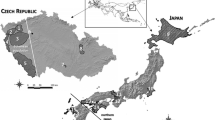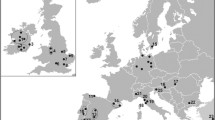Abstract
The Corsican red deer (Cervus elaphus corsicanus) is endemic to the Tyrrhenian islands of Corsica and Sardinia. It has been regarded as an introduced species and has allegedly been present on the islands since the beginning of the Neolithic culture some 8,000 years ago. In this review, we present the results of relevant genetic analyses and discuss their implications for the origin of C. e. corsicanus. Different genetic studies hypothesize that the most probable ancestral populations for Sardianian red deer were alternatively, the Near East, North Africa, or mainland Italy. These respective scenarios are evaluated and it is concluded that geneticists have not yet been unable to definitively solve the problem. However, a natural colonization of the Tyrrhenian islands from mainland Italy via the Tuscan archipelago is not only in accordance with palaeontological findings but also with at least some of the genetic data.

Similar content being viewed by others
References
Alcover JA, Seguí B, Bover P (1999) Extinctions and local disappearances of vertebrates in the western mediterranean islands. In: MacPhee RDE (ed) Extinctions in Near Time. Causes, Contexts, and Consequences. Kluwer Academic/Plenum Publishers, New York, pp 165–188
Avise JC (1989) Gene trees and organismal histories: a phylogenetic approach to population biology. Evolution 43:1192–1208
Beccu E (1989) Il Cervo Sardo. Delfino Ed., Cagliari
Bützler W (1986) Cervus elaphus Linnaeus, 1758 – Rothirsch. In: Niethammer J, Krapp F (eds) Handbuch der Säugetiere Europas, vol 2/II. Aula-Verlag, Wiesbaden, pp 107–139
Charlesworth JK (1957) The Quaternary Era with Special Reference to Its Glaciation, vol 2. Edward Arnold, London
Di Stefano G, Petronio C (2002) Systematics and evolution of the Eurasian Plio–Pleistocene tribe cervini (Artiodactyla, Mammalia). Geol Rom 36:311–334
Dolan JM (1988) A deer of many lands – a guide to the subspecies of the red deer cervus elaphus L. Zoonooz LXII(10):4–34
Feulner PGD, Bielfeldt W, Zachos FE, Bradvarovic J, Eckert I, Hartl GB (2004) Mitochondrial DNA and microsatellite analyses of the genetic status of the presumed subspecies cervus elaphus montanus (Carpathian red deer). Heredity 93:299–306
Flerov CC (1952) Musk Deer and Deer. Fauna of U.S.S.R., Mammals, vol I, 2. Academy of Sciences, Moscow
Frati F, Hartl GB, Lovari S, Delibes M, Markov G (1998) Quaternary radiation and genetic structure of the red fox Vulpes vulpes in the Mediterranean Basin, as revealed by allozymes and mitochondrial DNA. J Zool Lond 245:43–51
Funk DJ, Omland KE (2003) Species-level paraphyly and polyphyly: frequency, causes, and consequences, with insights from animal mitochondrial DNA. Annu Rev Ecol Evol Syst 34:397–423
Geddes D (1985) Mesolithic domestic sheep in West Mediterranean Europe. J Archaeol Sci 12:25–48
Geist V (1998) Deer of the World. Their Evolution, Behavior, and Ecology. Stackpole Books, Mechanicsburg, PA
Groves CP, Grubb P (1987) Relationships of living deer. In: Wemmer CM (ed) Biology and Management of the Cervidae. Research Symposia of the National Zoological Park. Smithsonian Institution Press, Washington, DC, London, pp 21–59
Hartl GB, Nadlinger K, Apollonio M, Markov G, Klein F, Lang G, Findo S, Markowski J (1995) Extensive mitochondrial-DNA differentiation among European Red deer (Cervus elaphus) populations: implications for conservation and management. Z Saugetierkd 60:41–52
Hartl GB, Zachos F, Nadlinger K (2003) Genetic diversity in European red deer (Cervus elaphus L.): anthropogenic influences on natural populations. C R Biol 326:S37–S42
Hmwe SS, Zachos FE, Eckert I, Lorenzini R, Fico R, Hartl GB (2006) Conservation genetics of the endangered red deer from Sardinia and Mesola with further remarks on the phylogeography of Cervus elaphus corsicanus. Biol J Linn Soc 88:691–701
Klein Hofmeijer G (1997) Late Pleistocene Deer Fossils from Corbeddu Cave. Implications for Human Colonization of the Island of Sardinia. BAR International Series 663. Hadrian Books, Oxford
Krumbiegel I (1982) Der korsika-rothirsch (Cervus elaphus corsicanus, Erxleben 1777) und sein Biotop. Saugetierkdl Mitt 30:281–286
Lever C (1985) Naturalized Mammals of the World. Longman, London
Lorenzini R, Fico R, Mattioli S (2005) Mitochondrial DNA evidence for a genetic distinction of the native red deer of Mesola, northern Italy, from the Alpine populations and the Sardinian subspecies. Mamm Biol 70:187–198
Lowe VPM, Gardiner AS (1974) A re-examination of the subspecies of Red deer (Cervus elaphus) with particular reference to the stocks in Britain. J Zool Lond 174:185–201
Ludt CJ, Schroeder W, Rottmann O, Kuehn R (2004) Mitochondrial DNA phylogeography of red deer (Cervus elaphus). Mol Phylogenet Evol 31:1064–1083
Lydekker R (1898) The Deer of All Lands. A History of the Family Cervidae Living and Extinct. Rowland Ward, London
Lydekker R (1915) Catalogue of the ungulate mammals in the British Museum (Natural History), vol IV Artiodactyla. British Museum (Natural History), London
Masseti M (1993) Post-Pleistocene variations of the non-flying terrestrial mammals on some Italian islands. Suppl Ric Biol Selvag 21:201–209
Masseti M, Vianello F (1991) Importazioni preistoriche di mammiferi alloctoni nelle isole del Mar Tirreno centro-settentrionale. Riv Sci Preist 43:275–292
Mattioli S (1990) Red deer in the Italian peninsula with particular reference to the Po delta population. Deer 8:95–98
Mattioli S, Fico R, Lorenzini R, Nobili G (2003) Mesola red deer: physical characteristics, population dynamics and conservation perspectives. Hystrix, Ital J Mammal 14:87–94
Niethammer G (1963) Die einbürgerung von säugetieren und vögeln in Europa. Paul Parey, Berlin
Pamilo P, Nei M (1988) Relationships between gene trees and species trees. Mol Biol Evol 5:568–583
Pereira E (2000) Les deux cervidés du pléistocène de corse. Abstract, The holarctic ungulates of the Pliocene and Pleistocene. Congress, Avignon, 19–22 September 2000
Peterson RL (1955) North American Moose. University of Toronto Press, Toronto
Sanges M (1987) Gli strati del neolitico antico e medio nella grotta corbeddu di oliena (Nuoro). Nota preliminare. Atti della XXVI Riunione Scientifica IIPP, Firenze, 7–10 Novembre 1985, pp 825–830
Schüle W (1993) Mammals, vegetation and the initial human settlement of the Mediterranean islands: a palaeoecological approach. J Biogeogr 20:399–412
Seton ET (1927) Lives of Game Animals, vol 3. Doubleday Doran, New York
Shackleton NJ (1987) Oxygen isotopes, ice volume and sea level. Quat Sci Rev 6:183–190
Søndaar P-Y (1977) Insularity and its effect on mammal evolution. In: Hecht MK, Goody PC, Hecht BM (eds) Major Patterns in Vertebrate Evolution. Plenum Press, New York, pp 671–707
Søndaar P-Y, Sanges M, Kotsakis T, de Boer PL (1986) The Pleistocene deer hunter of Sardinia.Geobios 19:17–25
Taberlet P, Fumagalli L, Wust-Saucy A-G, Cosson J-F (1998) Comparative phylogeography and postglacial colonization routes in Europe. Mol Ecol 7:453–464
Vigne J-D (1992) Zooarchaeology and the biogeographical history of the mammals of Corsica and Sardinia since the last ice age. Mamm Rev 22:87–96
Zachos F, Hartl GB, Apollonio M, Reutershan T (2003) On the phylogeographic origin of the Corsican red deer (Cervus elaphus corsicanus): evidence from microsatellites and mitochondrial DNA. Mamm Biol 68:284–298
Zachos FE, Hmwe SS, Hartl GB (2006) Biochemical and DNA markers yield strikingly different results regarding variability and differentiation of roe deer (Capreolus capreolus, Artiodactyla: Cervidae) populations from northern Germany. J Zool Syst Evol Res 44:167–174
Acknowledgements
Dr U. Schmölcke, Kiel, helped creating the map, which is gratefully acknowledged by the authors.
Author information
Authors and Affiliations
Corresponding author
Rights and permissions
About this article
Cite this article
Zachos, F.E., Hartl, G.B. Island Populations, Human Introductions and the Limitations of Genetic Analyses: the Case of the Sardinian Red Deer (Cervus elaphus corsicanus). Human Evolution 21, 177–183 (2006). https://doi.org/10.1007/s11598-006-9012-y
Received:
Accepted:
Published:
Issue Date:
DOI: https://doi.org/10.1007/s11598-006-9012-y




